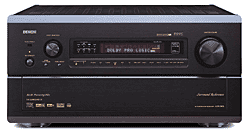|  Pure Signal Transmission For DVD-Audio Playback Pure Signal Transmission For DVD-Audio Playback
Denon Electronics is among the very few companies to address the long-standing
need for a high-resolution digital audio interface, given the availability
of very high-quality audio playback sources including DVD-Audio and SACD
for nearly three years. The foot-dragging to make a standardized high-resolution
digital audio connector a reality has come from the content providers,
who have demanded a secure, stringent copy protection protocol. In the
absence of a standardized high-quality connection solution, Denon has
developed their proprietary Denon Link, which is currently available with
the DVD-9000 DVD-Audio/Video player and the AVR-5803 home theatre receiver
(or the upgraded AVR-5800). Refer to Issue 68, January 2003 for the in-depth
reviews of these components.
 Denon Link Denon Link
The interface for the Denon
Link is an RJ-45 port. With the Denon Link, DVD-Audio can be passed
from playback source to receiver without conversion
to analog until the final output stage. A proprietary encryption
approach is used to keep the data secure between components. Another
key advantage
of a digital transmission for high-resolution audio is that full
bass management and loudspeaker time-distance compensation can be applied,
in this case from the receiver. In addition to DVD-Audio, the
Denon Link
can pass PCM audio from DVD-Video and CD, as well as Dolby® Digital
and DTS® Digital Surround™. Furthermore, the availability of
a single digital linkup replaces the current need for six analog
cables.
Denon began shipping the DVD-9000 and AVR-5803 before the “4C” licensing
group for DVD-Audio approved the transmission protocol. As a result, DVD-Audio
with copyrighted content greater than 48 kHz/16-bit would not pass through
the Denon Link. With the 4C approval, the interface is now known as the Denon
Link SE (Second Edition). Denon has begun upgrading existing DVD-9000s and
AVR-5803s. The update is to the firmware, and the servicing needs to be performed
by Denon. For more information, visit www.usa.denon.com.
Setup
Denon provides a
special RJ-45 Cat. 5 cable with the DVD-9000 player (a standard Cat.
5 patch cable will not work). The setup procedure is
very simple. Connect the Denon Link cable to the DVD player and
the receiver. Then, activate the Denon Link through the on-screen menus
for both components.
For the receiver, specify which source is to use the linkup.
Finally, from the receiver, make sure that channel output levels are
balanced (the
levels are independently set for Denon Link/multichannel input
playback). The receiver applies its global settings for bass management
and loudspeaker
time-distance compensation.
Using the Denon
Link, I found the ability to use a fully featured bass management system
in the receiver particularly useful. DVD-Audio
players typically have
very limited bass management capability, if at all. And there’s no guarantee
either that time-distance compensation will work properly, not to mention flexibly,
from a DVD player.
Performance
I compared the performance
for DVD-Audio using the Denon Link and analog multichannel interfacing.
Immediately, what I noticed was a subtle presence
in background hiss with the analog connections, whereas with
the Denon Link the hiss simply disappeared. As a result, playback through
the Denon
Link exhibited a slightly greater sense of dynamic clarity with
soft, gentle sounds. The onset of music instruments in the midst of
transient
yet apparent silence seemed a little more compelling when I listened
through the Denon Link.
The DVD-9000 player
uses somewhat higher-quality DAC devices than those used for the AVR-5803
receiver. I therefore expected
the DVD-9000 to produce a slightly
more refined sonic rendition, and this turned out to be the case. I noticed
that at the midrange and higher frequencies, the tonality sounded slightly
more “open” and articulate. It seemed as if the music was able
to “breathe” a little more. The “killer” application
for the Denon Link would be a new surround processor with the same DACs as
the DVD-9000.
Conclusion
Denon deserves a
great deal of credit for the development of an interfacing
solution for high-resolution audio, one that is much-needed
in the high-end consumer electronics industry. The Denon Link
exhibited a noticeable
advantage in audio performance, a result of simply preserving
the signal
in its
digital origination as much as possible, and further convincing
me of the need for the timely, widespread availability of high-quality
audio
interfacing. Of course, this will finally allow for the seamless
integration of a full complement of tried-and-true setup protocols
for full audio
system optimization. |